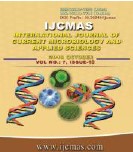


 National Academy of Agricultural Sciences (NAAS)
National Academy of Agricultural Sciences (NAAS)

|
PRINT ISSN : 2319-7692
Online ISSN : 2319-7706 Issues : 12 per year Publisher : Excellent Publishers Email : editorijcmas@gmail.com / submit@ijcmas.com Editor-in-chief: Dr.M.Prakash Index Copernicus ICV 2018: 95.39 NAAS RATING 2020: 5.38 |
Nutritional deficiencies, imbalances or erratic management of feeding programs for dairy cows can create various types of health problems generally referred as metabolic diseases. High producing lactating cows are the most susceptible to metabolic diseases during the periparturient period. During this period the animal is tremendously challenged to maintain calcium homeostasis because of physiological and pathological factors. Milk fever is an important metabolic disorder of dairy cattle around the time of calving. Several factors have been consistently associated with increased incidence of milk fever, including parturition and initiation of lactation, advancing age, breed, and diet. Clinical symptoms of this disease include in appetence, tetany, inhibition of urination and defecation, lateral recumbency, and eventual coma and death if left untreated. Parturient paresis is treated intravenously with calcium borogluconate. Of the various methods used in attempts to control the disease, the most progress has been made in dietary management. Until recently, most attention has focused on manipulating the levels of dietary calcium to control milk fever. Furthermore, as the dairy profitability is determined by the biological cycles of milk production and reproduction emphasis should be given on the nutritional management of dairy cows in the dry period as well as at parturition.
 |
 |
 |
 |
 |